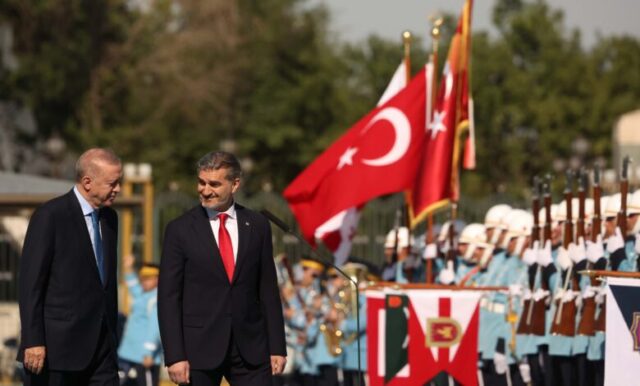
Turkish Transport Projects Reshape South Caucasus Connectivity
By:

Executive Summary:
- Türkiye is advancing the $1.615 billion Eastern Türkiye Railway Infrastructure Development Project (ETMIC), which will modernize the Divrigi–Kars–Georgia line with electrification, signaling, and advanced traffic management to boost freight and regional growth.
- Ankara is also planning the Samsun–Trabzon–Sarpi high-speed line linking central Türkiye with Georgia, and Georgia is constructing a new Batumi–Türkiye highway—jointly strengthening the Middle Corridor trade route.
- These projects deepen Türkiye’s regional connectivity ambitions, potentially aligning with Russian interests in reopening the Abkhazian railway, which could one day link Turkish and Russian rail systems through the South Caucasus.
Ankara plans to attract funds for the Eastern Türkiye Railway Infrastructure Development Project (ETMIC), which would renovate and electrify the Divrigi–Kars–Georgian border railway line. This was outlined in a document called “Request for Participation in Early Market Engagement for Procurement of: Eastern Türkiye Middle Corridor Railway Development Project (ETMIC) and Istanbul North Rail Crossing Project (INRAIL),” published by the Turkish Government and World Bank on September 25 (Government of Türkiye, September 25). The estimated cost of the ETMIC, including value-added tax (VAT), is $1.615 billion (BPN, October 10). The ETMIC would also construct bridges, tunnels, culverts, and retaining walls, and expand stations. The modern traffic management system includes substations, 154-kilovolt transmission lines, signaling and telecommunications equipment, a centralized traffic control system (CTC), and a 320-kilometer-long (199-mile-long) distributed acoustic monitoring system (DAS). The project will contribute to increased rail freight traffic, more active domestic passenger train traffic, and the economic development of the eastern parts of Türkiye (Report.az, October 4). Türkiye aims to position itself as a leading architect of connectivity in the region by implementing new regional projects.
Turkish President Recep Tayyip Erdoğan announced plans to build a new railway to the border with Georgia on January 5. The Samsun–Trabzon–Sarpi high-speed train line will provide rail transportation between the Turkish capital of Ankara, the Black Sea region, and Georgia (Republic of Türkiye Directorate of Communications; 1tv.ge, January 5). The new railway will connect the Turkish cities of Ordu, Giresun, Trabzon, Rize, and Artvin via a line starting in Samsun. The project is part of the Ankara–Kırıkkale–Çorum–Samsun high-speed line, which will facilitate traffic from the heart of the Anatolian peninsula to the Black Sea (Railmarket, June 19).
Georgia is also building an 11.3-kilometer (seven-mile) asphalt-concrete highway from Batumi to Türkiye. More than half of the route will be in a tunnel that circumvents densely populated areas (Business Media, August 22). The three projects—Türkiye’s new rail line to the border with Georgia, the ETMIC project, and Georgia’s highway linking Batumi and Türkiye—will help develop the Trans-Caspian International Transport Route (TITR), also known as the Middle Corridor, which links the Black Sea with Central Asia (see EDM, October 28, 2024, January 28, February 19, September 24).
Developing connectivity through the South Caucasus to Iran has also been an important part of Russia’s geopolitical interests (see EDM, January 16, March 13; Mehr News Agency, October 27). Russia already has an unhindered overland connection with Iran via Azerbaijan. In October, representatives of Azerbaijan, Iran, and Russia gathered to discuss plans to increase trade via the International North–South Transport Corridor (INSTC) to 15 million tons (Interfax, October 14).
Iran and Russia have also been expanding connectivity through Central Asia. These two routes are the branches of the INSTC that span from Russia’s hinterland to Iran and the Indian Ocean (see EDM, June 7, 2023, March 6, 2024, January 15). Iran is prioritizing the completion of the Astara–Rasht railway section near the Azerbaijan–Iran border, illustrating the importance of Russia–Iran connectivity for both countries (see EDM, May 16, 2022, March 19; News.am, October 22). Additionally, new north–south roads are being built in Georgia. The nearly half-billion-dollar Kvesheti-Kobi road, with bridges and tunnels, will greatly increase transit commerce between Russia and Armenia (Asian Development Bank, March 25; Business Media, September 22).
Türkiye and Georgia’s new railway lines and roads will bring the Turkish railway system closer to Georgia’s breakaway region of Abkhazia. While it will take many years to complete the new projects, it may eventually be in Russia’s and Türkiye’s interests to restore the defunct “Abkhazian railway” and connect the two countries’ railway systems. The Abkhazian railway section has been in disarray since the early 1990s, when the region became a source of separatist movement backed by Russia against the central government in Tbilisi. Russia has discussed the possible restoration of the railway (Russian Ministry of Foreign Affairs, June 3, 2008, June 28, 2023). The Abkhazian railway project would be a useful route to link Russia to Armenia and Iran (Georgian Foundation for Strategic and International Studies, July 10, 2023). When Türkiye completes its new railway projects to the Georgian border, the section from Abkhazia to Türkiye would be only around 150 kilometers (93.2 miles)—not a significant geographic distance for Ankara and Moscow to fill in the future. Russia may be interested in bridging that gap with Türkiye in the future to create a direct rail link between the two countries.



